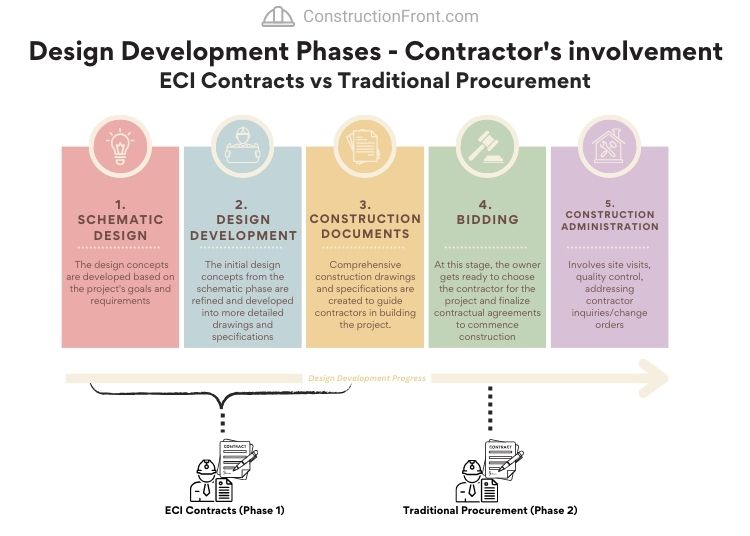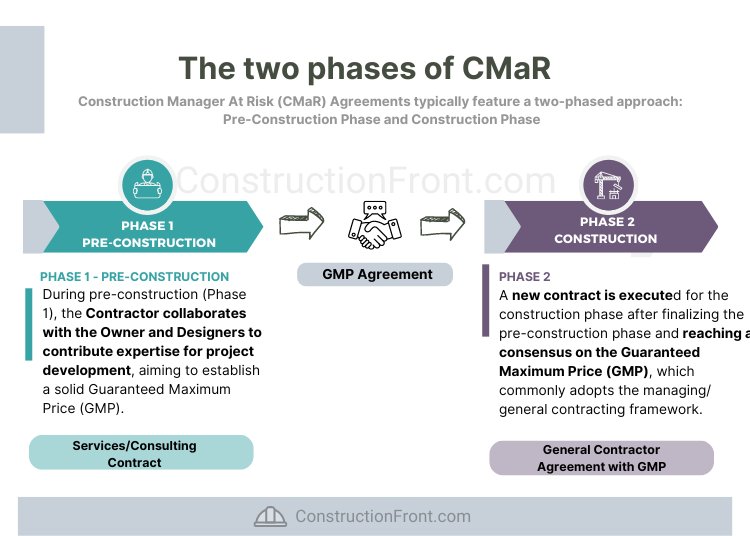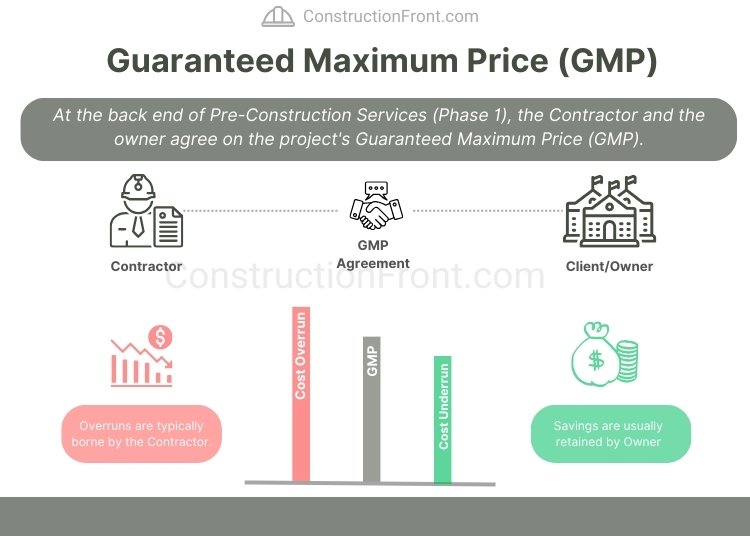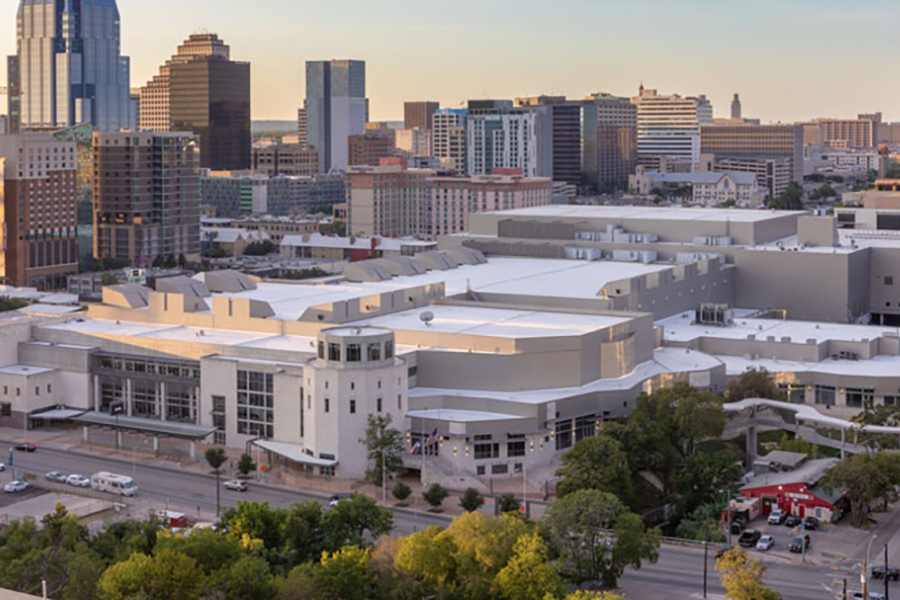Construction projects are known for their complexity and dynamic nature throughout their lifecycle. Over the last few decades, multiple contracting frameworks have been developed to improve risk allocation between the parties and optimise project outcomes.
Among them, the construction manager at risk, also known as CMaR or CM/GC, emerged as a robust alternative to enhance collaboration between owners and contractors, enable earlier involvement of the construction manager in planning and design, and proactively manage risks. It has been used in iconic projects, such as the New Oakland Athletics Ballpark in Las Vegas.
Overall, the concept of Construction Manager at Risk (CMaR) was an industry response to the challenges and limitations faced by traditional construction project delivery methods, which typically trigger adversarial relationships and decreased collaboration between the parties.
But how does CMaR contracting work? In this article, we will explore its mechanics, key features, pros and cons, suitability for your project, and other important characteristics – keep reading.
What is the Construction Manager at Risk (CMaR) Approach?
Construction Manager-at-Risk (CMaR) is an early contractor involvement strategy that seamlessly integrates owners, designers, contractors, and relevant stakeholders right from the project’s inception, which often can occur as early as the schematic or concept design phase.
Unlike conventional procurement approaches, which often engage contractors toward the end of design development, the CMaR framework allows contractors to be involved in the project as early as in the schematic design phase and support the project development.
Overall, CMaR is acknowledged for its collaborative approach, where contractors leverage their expertise and experience to optimize design development by:
- incorporating constructability aspects,
- delivering estimating support,
- taking into account innovations,
- value engineering exercises, and
- many other initiatives.
Suggested Reading: What is an ECI Contract?

How does CMaR work?
According to the Synthesis 402 of the National Cooperative Highway Research Program (NCHRP), the CMaR framework typically unfolds in two distinct phases:
- Phase 1 – Pre-Construction Services – This initial phase involves the contractor’s engagement to assist the client in the project’s preliminary development (further details below).
- Phase 2 – Construction Services – Once the design well advanced, a new contract is executed based on the Guaranteed Maximum Price (GMP) agreed on Phase 1.

CMaR - Phase 1 - Pre-Construction Services - Details
In the pre-construction services phase (Phase 1), the Contractor works closely with the Owner, Designers, Engineers, Architects, and other pertinent subject matter experts, and assumes a role akin to a consultant, where the main goal is to provide input, insights, and expertise to the project’s development and detailed design.
This collaborative effort encompasses a diverse range of responsibilities, including, but not limited to:
- Coordinating Overall Development
- Advising on Constructability Aspects
- Supporting Cost Planning and Estimating
- Implementing Value-Engineering
- Formulating Technical Specifications
- Crafting the Construction Program
- Packaging Procurement Processes
The scope of these services in this phase might vary to meet specific client requirements and ad-hoc arrangements. Typically, as the design matures to a certain level, the Contractor proceeds to furnish the client with a a Guaranteed Maximum Price (GMP).
What is the guaranteed maximum price (GMP)?
The Guaranteed Maximum Price (GMP) is the highest amount the contractor will charge the client for the construction project, which means that:
- If construction costs exceed the GMP, the contractor bears the risk of financial losses.
- If construction costs are lower than the GMP, the client/owner will retain the savings.

The GMP usually include the following elements:
- Construction Direct Costs (subcontract and self-performed works)
- Indirect/Overhead costs
- Profit Margin
- Contractor’s Contingency
Author’s Note:
- In some cases, some incentive mechanisms are incorporated into the contract, through which the owner/client and contractor can share the cost savings if they exist, replicating a common feature of alliancing contracting.
- Suggested Reading: What is an Alliance Contract? (Pros, Cons & Examples)
CMaR - Phase 2 - Construction Services
Once the pre-construction phase concludes and parties agree on a GMP, a new contract is executed for the construction works. The new agreement will usually implement the managing or general contracting framework with the GMP element.
In this phase, the contractor will proceed with the execution of the construction project based on the plans, schedules, and parameters established during the pre-construction phase.
The construction manager oversees the project’s implementation, manages subcontractors, monitors progress, and ensures compliance with the Guaranteed Maximum Price (GMP), contract requirements and specifications. The key tasks include:
Key Taks in Construction Phase | Description |
Implementation of Plans | Execution of plans and coordination of construction activities based on pre-construction phase documents. |
Procurement and Subcontractor Management | Sourcing materials, equipment, managing subcontractors, ensuring compliance with project specifications. |
Quality Control and Assurance | Monitoring and ensuring adherence to quality standards through inspections and quality assurance measures. |
Cost Management | Monitoring project costs, managing expenditures, and aligning expenses with the Guaranteed Maximum Price (GMP). |
Risk Management and Issue Resolution | Identifying and mitigating risks, addressing challenges, and adapting plans to keep the project on track. |
Communication and Reporting | Facilitating transparent communication, providing progress reports, and updating stakeholders on project status. |
Health, Safety, and Compliance | Upholding safety standards, ensuring compliance with regulations, and maintaining a safe working environment. |
Project Closeout | Finalizing inspections, documentation, payments, and transitioning the completed project to the owner/operator. |
Author’s Note: In contrast to traditional procurement methods (e.g., design-build and design-bid-build), the CMaR approach fosters collaboration and open communication by allowing contractor engagement from project inception.
Construction Manager at Risk (CMaR) - Key Features
As with every contracting methodology, the CMaR or CM/GC model comes with a suite of advantages and disadvantages, and some of them detailed below.
Construction Manager at Risk (CMaR) - Pros
Some of the key advantages of the CMaR contracting approach are:
- Early Involvement and Design Input: CMaR allows the construction manager to engage early in the project during the design phase, leveraging their expertise to provide valuable input and insights.
- Open-Book Basis: CMaR often operates on an “open book” basis, providing transparency in cost estimation and project finances, which offers owners valuable insights.
- Potential Incentive Mechanisms: In some instances, agreements include share-savings mechanisms, incentivizing contractors to deliver the works below the GMP.
- Collaborative Environment: It fosters stakeholder collaboration, enhancing communication and decision-making, potentially leading to optimized project outcomes.
- Efficient Risk Management: CMaR can allocate project risks more equitably between the owner and the construction manager, leading to a more balanced risk distribution and, ultimately, more efficient pricing.

Construction Manager at Risk (CMaR) - Cons and Challenges
However, there are some challenges associated with this delivery method, such as:
- Project Initial Costs are higher: The involvement of the CMaR entity from the early stages might incur higher initial costs than traditional procurement methods, as their services are engaged earlier in the project lifecycle. However, these higher initial costs are usually offset by the advantages of early involvement (e.g. better design).
- Potential Contractor-Designer Conflicts: In some instances, contractors and designers might have different agendas, leading to inevitable conflicts
- Increased Contract Management Burden: There are challenges associated with managing multiple contracts and their interfaces (i.e. multiple designers, CMaR Contractor)
- Construction Cost Uncertainty: The GMP is only known at the late stages of phase 1. Unforeseen expenses or design changes during the project development can impact the project’s viability.
- Trained Personnel: For successful outcomes, clients must use people with suitable skills and experience in dealing with complex project agreements.
When CMaR is used?
Construction Manager at Risk (CMaR) is often chosen for projects with specific characteristics or objectives, such as:
Complex and Large-Scale Projects |
|
Early Contractor Involvement is helpful |
|
Time-Sensitive Projects |
|
Risk Management Priority |
|
Construction Manager at Risk - Project Examples
Some of the recent projects that have implemented this approach are:
- Example 1 – Turner-JE Dunn JV to build the new Austin Convention Centre (Project Fact Sheet Below)
Project Name | Austin Convention Centre Redevelopment |
Project Details | Demolish existing centre and rebuild facility, nearly doubling its capacity |
Location | Austin, Texas, US |
Project Value | USD 1.2 Billion |
Client | City of Austin |
Contractor | Turner – JE Dunn JV |
Contract Style | Construction Manager at Risk (CMaR) |

- Example 2 – Tennesse Titans awards Construction Manager Contract to JV with Turner – (Project Fact Sheet Below)
Project Name | Tennessee Titans Stadium |
Project Location | Nashville, Tennessee – eastern portion of the current stadium campus |
Contracting Approach | Construction Management at Risk (CMAR) |
Construction Manager | Tennessee Builders Alliance (TBA) |
Construction Manager Entities | I.C.F. Builders, Polk & Associates, Turner Construction Company, AECOM Hunt |
Stadium Features | Circular translucent roof (enclosed stadium) 12,000 sq ft community space |
Project Timelines | Construction Commence: Early-to-mid 2024; Construction Completion: 2027 |

Alternatives to Construction Manager at Risk (CMaR)
There is a wide variety of contracting frameworks in the construction industry, such as:
- Managing Contractor
- Alliance Contracting
- Design and Construct (D&C) or Design-Build (DB) Contracts
- Front-end engineering design (FEED)
- Design-Bid-Build
- Public-Private Partnerships (PPP)
- Construction Only Contracts
- Other alternatives.
In the section, we will summarize the key differences of models that are typically compared against CMaR.
CMaR vs Design-Build (DB) vs Design-Bid-Build
The table below summarises the key differences between these three contracting methodologies.
Aspect | Design-Bid-Build | Design-Build | Construction Manager at Risk (CMaR) |
Contract Structure | Separate contracts between owner/designer and contractor | Single contract between owner and Design-Build entity
Owner typically develops design up to certain stage (30%), which is then handed over to the Design-Build Contractor | Owner typically has separate contracts with designer and CMaR Contractor |
Bidding Process | Competitive bidding after design completion | Competitive bidding using a preliminary design developed until certain stage (e.g. 30%)
| CMaR is selected based on ability and experience within project’s niche and past track-record with CMaR contracts |
Risk Allocation | Contractor assumes risks post-award, limited involvement in design. Design errors risks/updates are borne by Client | Design-Build entity assumes both design and construction risks | Construction manager bears significant construction risks and has significant input in design, which decreases client’s exposure |
CMaR vs Construction Manager / General Contractor (CM/GC)
CMaR and CM/GC are similar delivery methods, and each nomenclature will vary according to the jurisdiction in which it is used.
FAQ - Construction Manager at Risk (CMaR)
What is the difference between Guaranteed Maximum Price and Lump Sum?
A Lump Sum entails a fixed price for the entire project, encompassing all project elements. The contractor typically reaps the savings if the project is completed below the lump sum amount but also bears the risks of cost overruns.
Conversely, a Guaranteed Maximum Price sets a ceiling on project costs. The contractor bears responsibility for cost overruns unless the Guaranteed Maximum Price (GMP) is formally increased through a change/variation order approved for additional scope by the client.
Suggested Reading: What is a Variation Order? (With Templates and Examples)
What is a progressive GMP?
A progressive Guaranteed Maximum Price (GMP) is a pricing model in CMaR, where the GMP is adjusted to reflect changes in scope, design, costs, and other factors as the project and design progresses and more details emerge. This approach offers flexibility and ensures fair contracting terms.
Need Help?
Do not hesitate to contact us (click here) for specialised advice in the construction industry.
Sources and References?
- Construction Manager-at-Risk Project Delivery for Highway Programs
- Construction Manager at Risk (CMAR) Contracting | FEMA.gov
- Construction Manager at Risk – Benefits, Criteria, and Justification Criteria – Associated General Contractor of America
- Performance of the Construction Manager at Risk (CMAR) Delivery Method Applied to Pipeline Construction Projects
- An empirical survey of the motives and benefits of adopting guaranteed maximum price and target cost contracts in construction
- Construction Manager at Risk Delivery Overview (campbellcountywy.gov)
- Guaranteed Maximum Price – Univeristy of Colorado Boulder
- Contract Types – Associated Builders and Contractors















